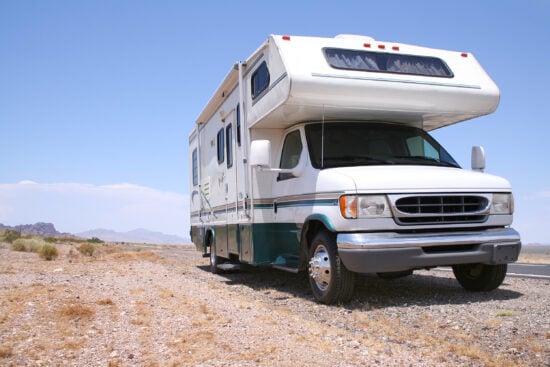You like taking the scenic routes, the coastal highways, the winding mountain roads, those quaint covered bridges…
But wait, can your RV even fit under those low bridges? What about tunnels? Do you need to avoid those? How tall is an RV anyway?
That answer depends on the type of RV you have and what kind of amenities you have on it. So here we’ll go over the standard heights of the different RV classes, along with tips for accident-free travel.
Knowing these heights helps you plan your trips and avoid dangerous low-clearance obstacles.
Key Takeaways
- Knowing your RV’s height, including any rooftop accessories, helps you plan safe travel routes and avoid clearance-related incidents.
- Typical heights for different RV classes are as such: Class A (12-14 feet), Class B (8-10 feet), Class C (10-12 feet), and Fifth Wheel Campers (12-13 feet).
- Using RV-specific GPS units and apps can help avoid low-clearance obstacles but always rely on your own awareness and caution when navigating routes.
Why Do You Need to Know Your RV’s Height?
RVs are significantly larger, longer, taller, and heavier than most personal vehicles, which means you need to take extra care and skill while driving. You need to plan your routes to ensure you avoid any low-clearance obstacles that could lead to roof damage (and, consequentially, roof repairs).
Imagine cruising along a scenic route only to encounter a low bridge that doesn’t accommodate your RV’s height. You can’t just stop. You’ve got cars behind you – and let’s be honest, you were so engrossed in your 80s classic hits that you didn’t even notice the bridge ahead. And then, bang! There goes your air conditioner rolling off the back of your RV and into the path of the car behind you–a nightmare scenario.
So when you measure the height of your RV, be sure to account for the height of any rooftop appliances like your air conditioning unit, satellite dish, or solar panels.
Typical Heights of Different RV Classes
RVs come in various shapes and sizes, each with its own height considerations.
Class A Motorhomes
With an average height of 12-14 feet, Class A motorhomes are the giants of the RV world. While the extra height can be cumbersome when it comes to route planning, don’t forget that this extra height translates to extra basement and overhead storage spaces, high ceilings, and room for bunks.
However, their substantial height and their not-so-substantial suspension means you should stay on paved, well-known routes that avoid low-hanging obstacles.
These are also the most likely RVs to have exterior amenities like rooftop porches or helipads. Do you not have one of those? Trust us, you’re not alone!
Class B Motorhomes
Class B motorhomes, also known as camper vans, are compact with a height between 8 and 10 feet. They’re designed for travelers who prioritize maneuverability and simplicity. This makes them the perfect RV for those who want to wander on the backroads and on forgotten paths.
Class C Motorhomes
Class C motorhomes fall within a range of 10-12 feet and offer a balance between size and maneuverability. These RVs offer a good mix of living space and drivability, making them a popular choice for families and couples.
The average exterior height of about 10 feet ensures that Class C motorhomes can navigate most routes without significant clearance issues.
Fifth-Wheel Campers
Fifth-wheel campers are a fan-favorite among RV owners, thanks to their spacious interiors and stable towing. Typically ranging from 10 to 14 feet in height, these RVs require careful measurements and planning to ensure seamless travel. Knowing the height of your fifth-wheel camper helps avoid unpleasant surprises when passing through tunnels, bridges, and other low-clearance areas.
How to Measure Your RV Height
Accurately measuring your RV’s height is a straightforward process that can save you from potential disasters.
To get the most accurate measurement, follow these steps:
- Parking your RV on a level surface to ensure precise measurements.
- Use a long measuring tape or a laser distance measurer to measure from the ground to the highest point of your RV, including any rooftop accessories like air conditioning units or satellite dishes.
It’s that easy, and you have the peace of mind that it’s the actual height – not the manufacturer’s estimated height.
Pro Tip: Record these measurements and keep them in a handy place like your glove box for reference during your travels.
Bridge Clearance Heights in the U.S.
In the U.S., bridge clearance heights are generally between 14 to 16 feet, although some states and lower traffic areas have lower clearances. However, the repaving of roads and highways can lower bridge clearance height by up to 2 inches, which you may forget to factor into your measurement. So, it’s best to give yourself extra breathing room.
While the majority of bridges exceed 13 feet 6 inches, staying alert and mindful of possible clearance challenges is always your best bet. If you do come across a low bridge, turn on your hazards and quickly (but carefully) move to the side. You may be in for a time-consuming detour, but that’s better than causing an accident and potentially getting fined.
Tips for Avoiding RV Height Clearance Incidents
All right, we all agree that taking a little off the top is a bad idea, so how do you avoid awkwardly sitting on the side of the road next to a low obstruction with no clear way to turn around?
1. Use an RV-Specific GPS to Plan Your Route
The great thing about an RV GPS is that it automatically takes into account your RV’s dimensions and gives you the best route.
2. Download RV Apps
There’s an app for plotting out routes that are safe for an RV of your dimensions. Apps like RV Life allow you to input your vehicle’s height and length and will generate customized routes that avoid low-clearance obstacles.
However, technology isn’t foolproof. Road repaving can adjust the clearance between road and bridge, and RV-specific GPS models and apps may not have up-to-date information.
3. Talk to Locals
Especially if you’re off-roading or boondocking, talk to locals or other RVers who’ve recently traveled to your spot to make sure it’s still passable with your RV.
4. Always Be Cautious and Aware While Driving
Take it slow when approaching bridges – many will have the clearance posted. Avoid anything that is less than a foot of your RV’s true height.
5. Be Aware of Other Potential Obstacles
Power lines, big tree branches, and the canopies at gas stations or drive-thrus are things you may not consider as
Summary
While you need to know your height for your RV road trip, you also need to know it for when it’s time to store it. You may have noticed that most RVs aren’t going to fit in the standard garage. Nonetheless, RVs should always be stored undercover to prevent damage from UV rays or storm debris. It also helps to keep leaves from accumulating and causing micro leaks.
So when your road trip comes to an end, and you need a place to store your RV so it’s ready for the next big trip and not riddled with maintenance issues that delay the fun, check out Neighbor.com.
Neighbor is a peer-to-peer RV storage marketplace that offers RV storage that’s up to 50% cheaper than traditional storage options.
With Neighbor, you can find RV storage options in all 50 states. You’ll even find storage spaces in your very own neighborhood. Find listings from pre-screened hosts nearest you!







